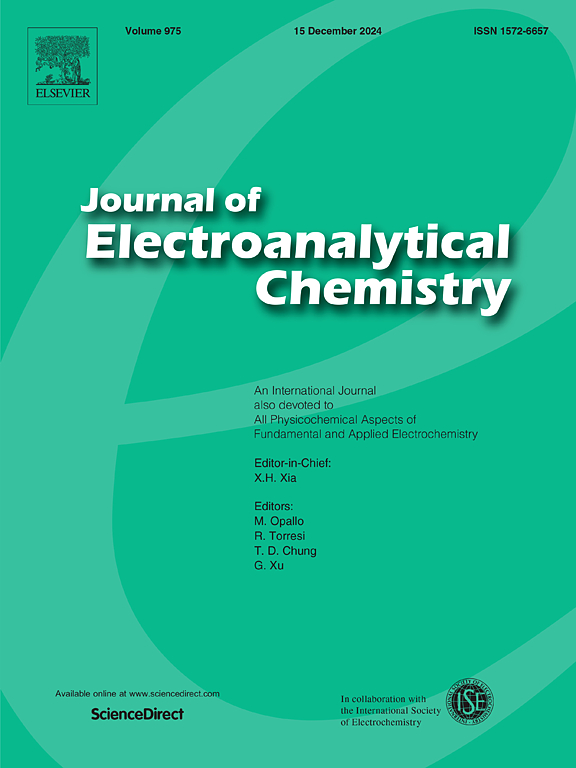Nanoarchitectonics of fully interpenetrating polymers with low-temperature pyrolysis modulation for double layer capacitor
IF 4.1
3区 化学
Q1 CHEMISTRY, ANALYTICAL
引用次数: 0
Abstract
Carbonization temperature controllable as a key bridge between precursor structure and electrochemical performance. This work investigates a fully interpenetrating polymer network precursor constructed with two molecular chains (o-Phenylenediamine-formaldehyde/potassium polyacrylate), a low-temperature pyrolysis strategy for systematically study the influence of direct carbonization temperature (500–800 °C) on the structural evolution and electrochemical properties of carbon materials derived from it, and obtained a series of porous carbon-based materials. By discussing in detail the physical characteristics of each sample such as morphology and structure, sample elements and pore structure, high-performance carbon-based materials with Sub nanometer micropores (∼0.6 nm) and mesopores coexisted were screened, sub nanopores can shorten ion diffusion pathways and provide abundant charge storage sites. When the carbonization temperature is at 700 °C, the carbon material C-IPN700 has a microporous specific surface area of up to 1168.268 m2 g−1 and possesses excellent storage capacity of 358 F g−1 at 0.5 A g−1, which is comparable to the optimal specific capacitance of IPNs-derived carbon materials used so far for double-decker capacitors, and after 9000 long cycle tests, the coulomb efficiency is close to 100%. C-IPN shows high energy density of 9.72 Wh Kg−1 at 125 W Kg−1 power density when used as a symmetric device. For the field of bilayers, C-IPN700 is a potential low-cost, easy-to-prepare low-temperature pyrolyzed carbon material with high energy storage efficiency.

低温热解调制双层电容器中完全互穿聚合物的纳米结构
碳化温度可控是前驱体结构与电化学性能之间的关键桥梁。本工作研究了由两条分子链(邻苯二胺-甲醛/聚丙烯酸钾)构建的完全互穿聚合物网络前驱体,采用低温热解策略,系统研究了由其衍生的直接碳化温度(500-800℃)对碳材料结构演变和电化学性能的影响,并获得了一系列多孔碳基材料。通过详细讨论各样品的形貌和结构、样品元素和孔隙结构等物理特性,筛选出亚纳米微孔(~ 0.6 nm)和介孔共存的高性能碳基材料,亚纳米孔可以缩短离子扩散途径并提供丰富的电荷存储位点。当炭化温度为700℃时,碳材料C- ipn700的微孔比表面积高达1168.268 m2 g−1,在0.5 ag−1下具有358 F g−1的优异存储容量,与目前用于双层电容器的ipns衍生碳材料的最佳比电容相当,经过9000次长循环测试,库仑效率接近100%。作为对称器件使用时,C-IPN在125 W Kg−1功率密度下的能量密度高达9.72 Wh Kg−1。在双分子层领域,C-IPN700是一种有潜力的低成本、易于制备的低温热解碳材料,具有较高的储能效率。
本文章由计算机程序翻译,如有差异,请以英文原文为准。
求助全文
约1分钟内获得全文
求助全文
来源期刊
CiteScore
7.80
自引率
6.70%
发文量
912
审稿时长
2.4 months
期刊介绍:
The Journal of Electroanalytical Chemistry is the foremost international journal devoted to the interdisciplinary subject of electrochemistry in all its aspects, theoretical as well as applied.
Electrochemistry is a wide ranging area that is in a state of continuous evolution. Rather than compiling a long list of topics covered by the Journal, the editors would like to draw particular attention to the key issues of novelty, topicality and quality. Papers should present new and interesting electrochemical science in a way that is accessible to the reader. The presentation and discussion should be at a level that is consistent with the international status of the Journal. Reports describing the application of well-established techniques to problems that are essentially technical will not be accepted. Similarly, papers that report observations but fail to provide adequate interpretation will be rejected by the Editors. Papers dealing with technical electrochemistry should be submitted to other specialist journals unless the authors can show that their work provides substantially new insights into electrochemical processes.

 求助内容:
求助内容: 应助结果提醒方式:
应助结果提醒方式:


